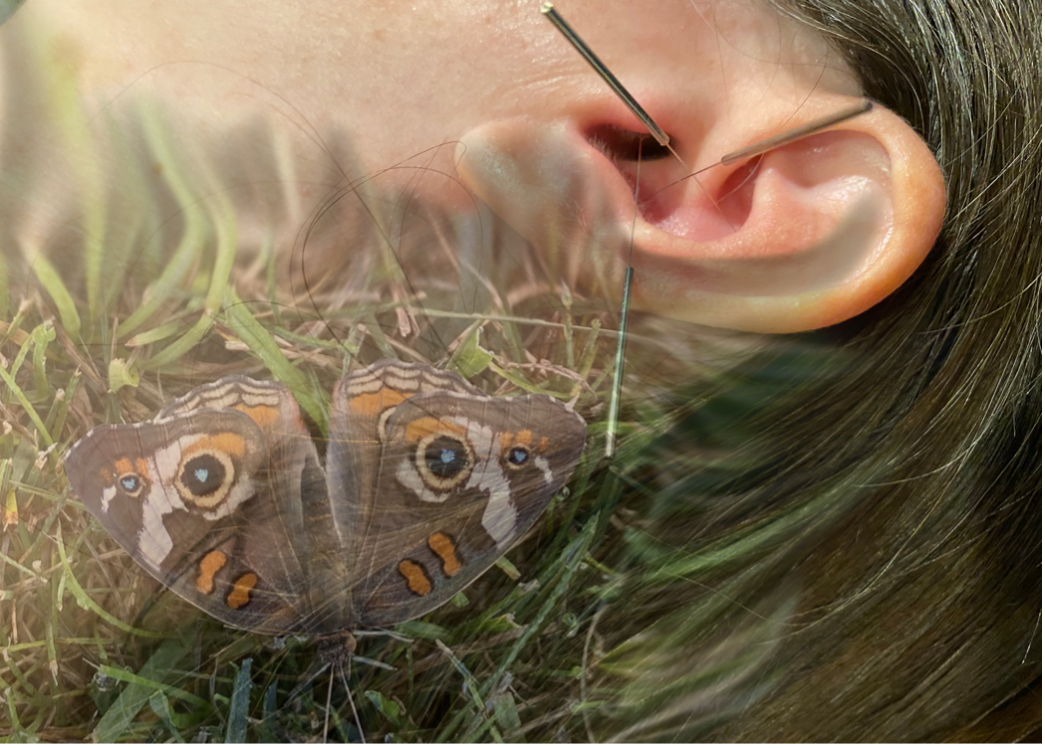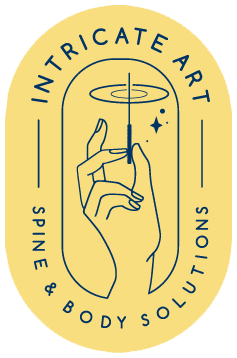
Electrical Dry Needling for Auricular Vagus Nerve Stimulation to Reduce Sympathetic Autonomic Nervous System Hyperactivity & Regulate the ANS Toward Homeostasis
Remember, the overwhelming majority of physical therapy patients present with sympathetic autonomic nervous system (SANS) hyperactivity. The human body and mind respond to physical and emotional stress, trauma, pain, etc., by elevating sympathetics. Elevated sympathetic activity reciprocally inhibits parasympathetic autonomic nervous system (PANS) activity. Chronic sympathetic autonomic hyperactivity is detrimental to all aspects of physical and mental well-being. It leads to body wide inflammation, pain / hyperalgesia, tissue rigidity, hypoxia, hormone imbalance, anxiety, depression, intestinal issues, and the list goes on.
The auricular branch of the vagus nerve, cranial nerve X, innervates multiple areas of the ear. This is the most direct, powerful PANS-specific treatment we can perform. The Vagus nerve is sometimes referred to as the “wandering nerve” because of its meandering path leading from the brainstem to the heart, organs, intestines, aorta, and more. It innervates a lot more unique structures than any other nerve I’m aware of. It is the primary nerve of the PANS and about 80% of the nerve fibers are afferent, indicating its main job is to tell the brain what is going on in our organs and other subconscious bodily functions, so our brain can monitor and regulate what is going on. The vagus nerve gives our brain interoceptive awareness, or awareness of what is going on inside our body.
3 Common Vagus Nerve Ear Distributions to Target & Regulate the Autonomic Nervous System Toward Homeostasis:
- Concha
- Cymba Concha
- Inner Tragus
Targeting the parasympathetic autonomic nervous system with needles has a homeostatic effect on the ANS via sympathetic depression and other neurophysiologic mechanisms. We know so little about the mechanisms of action that lead to this, but we do know the overall result of vagus nerve and parasympathetic-specific needling. There is good research looking at surgical vagus nerve stimulation with a metal cuff placed around the nerve itself, and good acupuncture research looking at vagus nerve stimulation via its auricular distribution in the ear. A recent meta-analysis found high efficacy in depressing sympathetic hyperactivity and bringing the ANS towards homeostasis in both auricular stimulation and surgical implantation. Obviously better to avoid surgery. It is already FDA approved for epilepsy, anxiety and depression. People are looking at its effect on anxiety, chronic pain, autoimmune disease, insulin resistance, heart irregularities, mental health, and much more.
The amount of research on vagus nerve stimulation has significantly increased over the last few years, which is awesome. Hopefully this becomes a widespread treatment for a multitude of mental and physical impairments. It certainly should be. Auricular vagus nerve electrical dry needling consistently produces incredibly powerful results in my patients. An awesome thing about this is it works for a massive range of medical impairments. All conditions do better with a more homeostatic ANS, and stimulating the vagus nerve is the most powerful place we can access with needles to directly induce ANS homeostasis. It helps regulate the primary axes of the ANS, the hypothalamic-pituitary-adrenal (HPA) axis and the gut-brain axis (enteric nervous system + brain). Remember, the gut plays a large role in regulating mood, serotonin, dopamine, immunity, and we are learning more and more about how important it is all the time.
To maximize treatment efficacy and ANS homeostasis, it is important to include low frequency (1-5 Hz) microcurrent. It really helps. Remember, don’t use regular stim with needles, people will not like you, it hurts, too many amps. 1-5 Hz has consistently shown across electrical research to be the best frequency to stimulate endogenous opioid (beta endorphin) release from the hypothalamic-pituitary-adrenal (HPA) axis. Up to 4 times the amount of beta endorphin becomes accessible when using low frequency stim with your needles. Beta endorphin reduces pain, which alone reduces sympathetic activity. It also has other mechanisms of action that we are trying to understand. I like to use 1 Hz microcurrent, closest to normal heart beat, and connect the parasympathetic dominant areas of the body to each other, in various ways. The other 2 parasympathetic-dominant locations to access with electrical dry needling are the sacral plexus, S2-S4, and the suboccipital periosteum / C2 spinous process. Placing current through periosteal tissue and needling bilaterally are things I do as often as possible, it appears to induce a more powerful homeostatic, healing effect.
I place 3 needles in each ear, or in one ear if that is all I can access, as the first needles of my treatments. I then place needles in the other 2 areas I mentioned above, depending on patient position. Then I treat whatever else I am going to, hook up the microcurrent, and leave the patient for 20-30 minutes. Leaving the needles in place for over 20 minutes is ideal.
Let me know if anyone has any questions about signing up for a course to learn these techniques or if you are looking for someone we have trained. We offer 4 dry needling and 3 manipulation courses, along with 3 unique certifications, Thanks.
Related: Click here to learn more about our available certifications
Jason
Jason@intricateartseminars.com
DISCLAIMER: The content on the blog for Intricate Art Spine & Body Solutions, LLC is for educational and informational purposes only, and is not intended as medical advice. The information contained in this blog should not be used to diagnose, treat or prevent any disease or health illness. Any reliance you place on such information is therefore strictly at your own risk. Please consult with your physician or other qualified healthcare professional before acting on any information presented here.
References
Vagus Nerve Stimulation
-
Butt, M.F., Albusoda, A., Farmer, A.D. and Aziz, Q., 2020. The anatomical basis for transcutaneous auricular vagus nerve stimulation. Journal of anatomy, 236(4), pp.588-611. -
Garner, B.K., Hopkinson, S.G., Ketz, A.K., Landis, C.A. and Trego, L.L., 2018. Auricular acupuncture for chronic pain and insomnia: a randomized clinical trial. Medical acupuncture, 30(5), pp.262-272. -
Jaić, K.K., Turković, T.M., Pešić, M., Djaković, I., Košec, V. and Košec, A., 2019. Auricular acupuncture as effective pain relief after episiotomy: a randomized controlled pilot study. Archives of gynecology and obstetrics, 300(5), pp.1295-1301 -
Johnson, R.L. and Wilson, C.G., 2018. A review of vagus nerve stimulation as a therapeutic intervention. Journal of inflammation research, 11, p.203. -
Kang, H.R., Lee, Y.S., Kim, H.R., Kim, E.J., Kim, K.H., Kim, K.S., Jung, C.Y. and Lee, J.K., 2017. A clinical study of electroacupuncture and auricular acupuncture for abdominal pain relief in patients with pancreatitis: A pilot study. Korean Journal of Acupuncture, 34(1), pp.47-55. -
Moura, C.D.C., Chaves, E.D.C.L., Cardoso, A.C.L.R., Nogueira, D.A., Azevedo, C. and Chianca, T.C.M., 2019. Auricular acupuncture for chronic back pain in adults: a systematic review and metanalysis. Revista da Escola de Enfermagem da USP, 53. -
Sator-Katzenschlager, S.M., Szeles, J.C., Scharbert, G., Michalek-Sauberer, A., Kober, A., Heinze, G. and Kozek-Langenecker, S.A., 2003. Electrical stimulation of auricular acupuncture points is more effective than conventional manual auricular acupuncture in chronic cervical pain: a pilot study. Anesthesia & Analgesia, 97(5), pp.1469-1473. -
Shah, A.N., Moore, C.B. and Brigger, M.T., 2020. Auricular acupuncture for adult tonsillectomy. The Laryngoscope, 130(8), pp.1907-1912. -
Sprouse-Blum, A.S., Smith, G., Sugai, D. and Parsa, F.D., 2010. Understanding endorphins and their importance in pain management. Hawaii medical journal, 69(3), p.70. -
Taylor, S.L., Giannitrapani, K.F., Ackland, P.E., Thomas, E.R., Federman, D.G., Holliday, J.R., Olson, J., Kligler, B. and Zeliadt, S.B., 2021. The Implementation and Effectiveness of Battlefield Auricular Acupuncture for Pain. Pain Medicine. -
Tsai, S.L., Fox, L.M., Murakami, M. and Tsung, J.W., 2016. Auricular acupuncture in emergency department treatment of acute pain. Annals of emergency medicine, 68(5), pp.583-585. -
Usichenko, T.I., Dinse, M., Hermsen, M., Witstruck, T., Pavlovic, D. and Lehmann, C., 2005. Auricular acupuncture for pain relief after total hip arthroplasty–a randomized controlled study. Pain, 114(3), pp.320-327. -
Usichenko, T.I., Kuchling, S., Witstruck, T., Pavlovic, D., Zach, M., Hofer, A., Merk, H., Lehmann, C. and Wendt, M., 2007. Auricular acupuncture for pain relief after ambulatory knee surgery: a randomized trial. Cmaj, 176(2), pp.179-183. -
Usichenko, T.I., Lehmann, C. and Ernst, E., 2008. Auricular acupuncture for postoperative pain control: a systematic review of randomised clinical trials. Anaesthesia, 63(12), pp.1343-1348. -
Yeh, C.H., Chiang, Y.C., Hoffman, S.L., Liang, Z., Klem, M.L., Tam, W.W., Chien, L.C. and Suen, L.K.P., 2014. Efficacy of auricular therapy for pain management: a systematic review and meta-analysis. Evidence-Based Complementary and Alternative Medicine, 2014. -
Prescott, S.L. and Liberles, S.D., 2022. Internal senses of the vagus nerve. Neuron. -
Badran, B.W., Brown, J.C., Dowdle, L.T., Mithoefer, O.J., LaBate, N.T., Coatsworth, J., DeVries, W.H., Austelle, C.W., McTeague, L.M., Yu, A. and Bikson, M., 2018. Tragus or cymba conchae? Investigating the anatomical foundation of transcutaneous auricular vagus nerve stimulation (taVNS). Brain stimulation, 11(4), p.947. -
Bonaz, B., Sinniger, V. and Pellissier, S., 2021. Therapeutic potential of vagus nerve stimulation for inflammatory bowel diseases. Frontiers in neuroscience, 15, p.300. -
Burger, A.M., D’Agostini, M., Verkuil, B. and Van Diest, I., 2020. Moving beyond belief: A narrative review of potential biomarkers for transcutaneous vagus nerve stimulation. Psychophysiology, 57(6), p.e13571. -
Ottaviani, M.M., Wright, L., Dawood, T. and Macefield, V.G., 2020. In vivo recordings from the human vagus nerve using ultrasound‐guided microneurography. The Journal of physiology, 598(17), pp.3569-3576.



